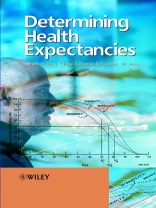Health expectancies were developed to address the important
question of whether or not we are exchanging longer life for poorer
health – replacing quality by quantity.
Health expectancies extend the concept of life expectancy to
morbidity and disability by providing a means of dividing life
expectancy into life spent in various states of good and bad
health. Being independent of the size of populations and of their
age structure, health expectancies thus allow direct comparison of
the different groups that constitute populations: sexes,
socio-professional categories, regions.
This book brings together for the first time, the major works of
REVES* over the past ten years. As well as providing comparisons of
the health of many of the world’s countries, the book includes
sections on the concepts behind health expectancies and the
demographic transition, the relevance of health expectancies to
health policy and the different methods of calculating health
expectancies.
*REVES is an international organisation of researchers, clinicians
and health planners addressing these issues as well as developing
and recommending methods of calculation and furthering the use of
health expectancy as a tool for health planning.
* State-of-the-art coverage of this important health indicator
* Heavily cross referenced to give the book structure and coherence
* Editors are pioneers in the field of health expectancy
Tabla de materias
List of Contributors.
List of Abbreviations.
Introduction (J. Robine, et al.).
PART I: THE MAIN TRENDS IN THE EVOLUTION OF THE POPULATION’S
HEALTH STATUS.
Introduction (J. Robine).
Increase in Life Expectancy and Concentration of Ages at Death
(F. Meslé and J. Vallin).
Compression of Morbidity (W. Nusselder).
Patterns of Disability Change Associated with the Epidemiologic
Transition (G. Myers, et al.).
Trends in Health Expectancies (J. Robine, et al.).
PART II: THE RELEVANCE OF HEALTH EXPECTANCIES.
Introduction (E. Crimmins).
Social Inequalities in Health Expectancy (E. Crimmins and E.
Cabois).
Sub-national Variations in Health Expectancy (A. Bebbington and
M. Bajekal).
Cause-deleted Health Expectancies (C. Mathers).
Mental Health Expectancy (K. Ritchie and C. Polge).
PART III: MEASUREMENT, COLLECTION AND CALCULATION PROBLEMS.
Introduction (C. Jagger).
Data Collection Methods and Comparability Issues (V. Buratta and
V. Egidi).
Disability Measurement (D. Deeg, et al.).
The Evolution of Demographic Methods to Calculate Health
Expectancies (S. Laditka and M. Hayward).
Health-adjusted Life Expectancy (HALE) (J. Berthelot).
Disability-Adjusted Life Years (DALYs) and Disability-adjusted
Life Expectancy (DALE) (J. Barendregt).
Classification and Harmonisation (H. Boshuizen and R.
Perenboom).
PART IV: HEALTH EXPECTANCIES IN THE DIFFERENT REGIONS OF THE
WORLD.
Introduction (C. Mathers).
Health Expectancy in Asian Countries (Y. Saito, et
al.).
Ageing and Health Expectancies in Urban Latin America (R.
Ham-Chande).
Global Patterns of Health Expectancy in the Year 2000 (C.
Mathers, et al.).
Health Expectancies in European Countries (R.
Perenboom, et al.).
Health Expectancy Research in North American Countries (V.
Lamb).
Health Expectancy in Australia and New Zealand (P. Davis, et
al.).
Index.
Sobre el autor
Jean-Marie Robine is a French demographer, gerontologist, author and journalist, who is best known as being the co-validator of the longevity of Jeanne Calment, the oldest verified supercentenarian of all time, with whom he collaborated. Carol Jagger is the editor of Determining Health Expectancies, published by Wiley.












